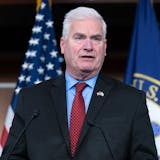Rarely has a U.S. city done what Minneapolis has managed to do over the past several years: Commission some of the world's leading landscape architects to design projects in and around its downtown.
Why does that matter?
It matters because cities that want to attract talented people have to make good first impressions.
When all eyes are on Minneapolis during the 2018 Super Bowl and the 2019 Final Four, with people arriving from all over the world to U.S. Bank Stadium, they will see a park — Downtown East Commons — with people gathering on a great lawn, engaging in outdoor activities along a 4th Street promenade, skating on a water plaza and warming up in a glass-enclosed pavilion. Designed by the internationally known landscape architecture firm Hargreaves Associates, with local talent — Damon Farber Associates and VJAA — also on the team, this open space will reflect our region well: the capital city of America's North, with people unafraid of cold weather, remaining active year-round.
The commissioning of top designers also matters because cities that want to keep their talent need to provide stimulating places in which to interact. Five blocks east of the Commons park, visitors will find a new Nicollet Mall, designed by an equally noted team of James Corner Field Operations (which did the celebrated High Line in New York City), with local design firms including Coen + Partners and Snow Kreilich Architects. The 12-block-long space will have areas for people to relax under groves of trees, to read in an outdoor "reading room," to participate in activities within a central "island" and to work or people watch from the many places to sit along the route.
Another kind of interaction space will rise next to Walker Art Center. Dutch designer Petra Blaisse has worked with the local firm HGA to envision a landscape that encourages conversation and activity, with a path that winds uphill and back down through a series of tree clusters, while also allowing for the large gatherings of people who attend the Walker's outdoor films or its music festival. The reconstruction of the 26-year-old Minneapolis Sculpture Garden, designed by the local landscape architecture firm Oslund and Associates, will make the Walker campus a compelling destination for anyone interested in exercise or the arts.
Cities need more than talent from elsewhere; they also need to nourish the potential of every one of their residents and to give them all equal access to the opportunities cities have to offer. RiverFirst, designed by a top-flight Berkeley/Boston team of Tom Leader Studio and Kennedy & Violich Architecture, will do just that as it opens up both banks of the Mississippi River, north of downtown, to the adjacent neighborhoods long separated from the water by buildings and industry. Their design, for example, calls for linking the bike lanes along a reconstructed 26th Avenue N. to Ole Olson Park, which would connect north Minneapolis to the rest of the city's extensive bike and walking paths and give citizens much easier access to downtown and major institutions, helping overcome decades of physical isolation.
Making most of natural assets
Taking advantage of natural assets also characterizes great cities. In downtown Minneapolis, that means connecting the city to the Mississippi, as Water Works, one of the RiverFirst projects, will do. Designed by a star among younger U.S. landscape architects, Kate Orff of SCAPE, along with the New York architects Rogers Partners and the local firm SRF Consulting, Water Works will enable city residents to literally get their feet wet by the river, with a water plaza for wading, a boat launch for kayakers and canoeists and a shallow cataract among the mill ruins. Additional features, such as outdoor game areas, an amphitheater and a pavilion in which to eat, relax and warm up or cool off, provide more passive ways of enjoying the river.



